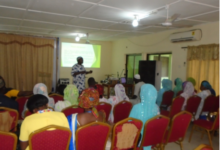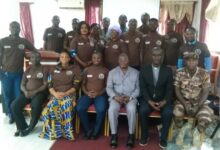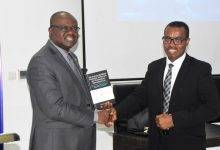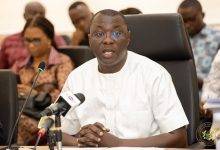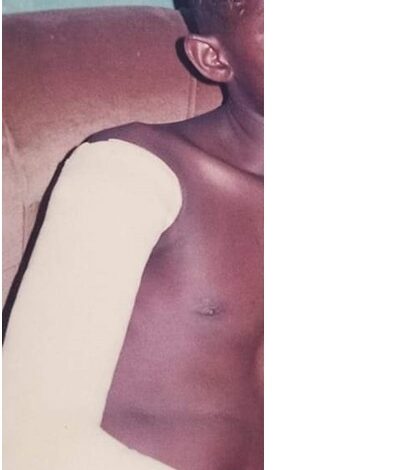
“When I regained consciousness later that afternoon, I was at the accident centre of the Tema General Hospital, in pain and with so much commotion around; health officers were frantically doing their best to save lives.
“I couldn’t raise my right arm; the bone was broken. I had a head injury (what the doctors call cerebral concussion and scalp laceration) at the right parietal region. My mother stood by my bed calling on Jesus to save her son.
“When another victim who was on the bed next to mine passed on, my mother’s shout unto the Lord became even more intense. Grace found me, and I wasn’t added to the statistics of the number of deaths”, narrated Samuel Tetteh, a crash survivor.
It’s been 18 years since the preacher and insurance agent, now in his forties, survived the crash caused by a tyreburst, but time which is hailed as the healer of all wounds seems not to have given him a clean bill of health.
He is still battling intermittent strain in his right arm and relieving the pain is costing him an arm and leg literally. Sadly, he is one of the people paying dearly for the defective tyres on the country’s roads.
Recap
In the first part of this article titled “Tired tyres and the tragedy tied to them” published on February 27 in print and online, it was established that defective tyres were deadly, per a study by the National Road Safety Authority (NRSA).
The lack of a laboratory to thoroughly check imported tyres, the appetite for used tyres, and the gaps in the implementation of Regulation 62 of the Road Traffic Regulation 2012 (LI 2180) on tyres were discussed with regulatory authorities, and that gave them the chance to explain the situation.
The article drew the attention of duty bearers to take the issues of defective or used tyres seriously to help them from taking lives.In this concluding part, the focus is on the economic and emotional cost of crashes on a victim and the country.
The crash
On February 23, 2005, MrTetteh, then a national service person with Cleaning Solutions Limited in Tema, was on board a Mazda Mini-bus with registration number GR 7775 P, from the 37 lorry station to Tema.
At about 7a.m., on the Accra-Tema motorway, specifically close to the Abattoir, the rear offside tyre of the mini-bus got burst and the driver lost control of the steering, running into a Volvo saloon car and then somersaulting into the bush. Many of the passengers died.
The cost
Since his discharge from the hospital, his arm has not been the same as before.
“Every week, I spend about GHc500 managing the pain .I tie it with local roots and bandages. I’m trying to do away with painkillers,” he said.
Mr Tetteh is not handicapped but when the pain gets worse, his handiness is capped as his arm would have to be in a sleigh.
Last month, on the anniversary of the incident he had to struggle to write an examination because his arm was in bandage due to excessive pain.
He has taken a break from social media, where he shares the gospel to more than 3,000 friends, to enable him to heal.
But for the benevolent persons in his life, who ensured that he got the best of treatment in addition to prayers, he would have been suffering more than he is now. He could have lost his arm. He could not recall how much went into the treatment, but remembers it cost thousands of cedis.
“My current straining of that fractured right arm is nothing to complain about. It’s rather a reminder of the faithfulness of Jehovah Rapha,” he said.
National level
While Mr Tetteh spends about GHc26, 000 annually on his arm, Ghana is estimated to spend up to $230 million every year treating injuries and traffic fatalities.
According to a Senior Specialist in Trauma and Orthopaedic Surgery at the Komfo Anokye Teaching Hospital, Dr. Dominic Konadu Yeboah, many fracture cases are reported to hospitals.
He said there were inadequate orthopaedic surgeons — medical professionals who specialise in diagnosing, treating injuries to bones, joints, muscles and nerves — in the country, a situation that limits access to emergency treatment.
“Over $230 million is lost annually to trauma in Ghana, and we also have figures that suggest that in a period of one year, we have over 5,000 reported fractures so the situation that pertains is more serious than what we see. Therefore, we want to encourage dissemination of information on trauma and all injuries,” he told journalists at a training on trauma reporting.
“In doing so, we get to appreciate the enormity of the problem, the disabilities, the deaths that this problem is costing us as Ghanaians, and economic losses, so that we place it on top of our healthcare agenda and give it the prominence it deserves,” Dr Yeboah said.
The National Health Insurance Scheme covers the basic cost of roadcrashes, but victims who need extra care and prosthetics would have to cough out thousands of dollars .
Post-crash care worsens the burdens of families. The victims who are unable to afford the required treatment have to struggle through the rest of their lives with the entire trauma that comes with it.
Global perspective
The Global Road Safety Facility (GRSF) is a global multi-donor fund hosted by the World Bank. In its profile of Ghana and “The scale of the road safety challenge”, it estimates that the cost of fatalities and serious injuries in 2016 was $4.5 billion, representing 8.2 percent of the country’s GDP. As of that time 976 life years had been lost due to disability from road crash injuries per 100,000 people.
According to the World Health Organisation (WHO), the lives of almost 1.3 million people are cut short annually as a result of traffic accidents. There are an additional 20 to 50 million people who sustain non-fatal injuries, but many of whom go on to develop disabilities.
Road traffic accidents result in significant economic damages for victims, their families, and entire countries. These costs result from the price of medical care, lost wages for individuals who are killed or rendered incapacitated by their injuries, and caregiving expenses by family members who must take time off from work or school to look after the injured.
Most nations lose three per cent of their GDP to road accidents, according to WHO. Meanwhile the UN’s Sustainable Development Goals target 3.6 enjoins countries to halve the number of global deaths and injuries from road traffic crashes.
Call to action
Although the 2022 NRSA statistics indicate that for the first time in 20 years, crashes on the roads reduced by 20 per cent, road crashes and fatalities remain a grave concern in the country.
The 2,373 people who lost their lives and the 15,690 injured in 14,960 reported road crashes, which involved 25,754 vehicles, could have been saved, if all stakeholders, including drivers and regulators, had put in more effort to check all factors of road crash, including the issue of defective tyres.
BY JONATHAN DONKOR

